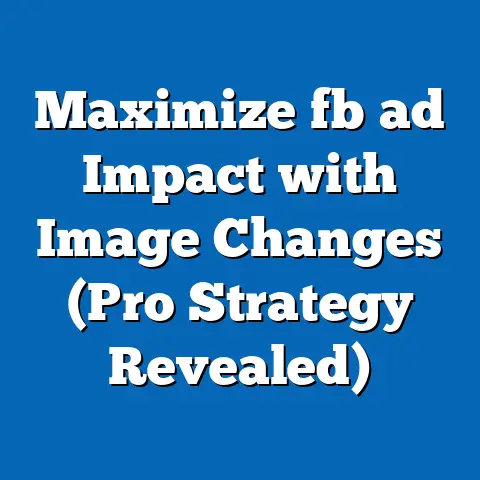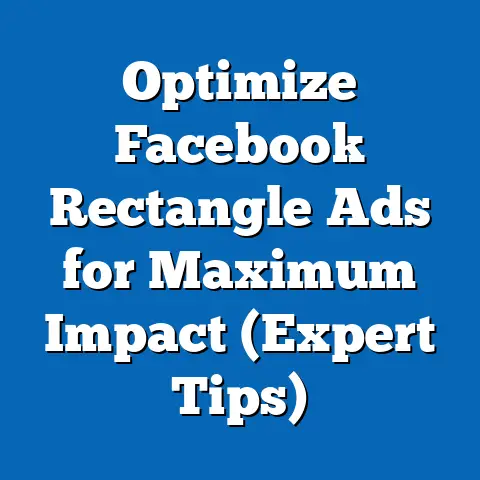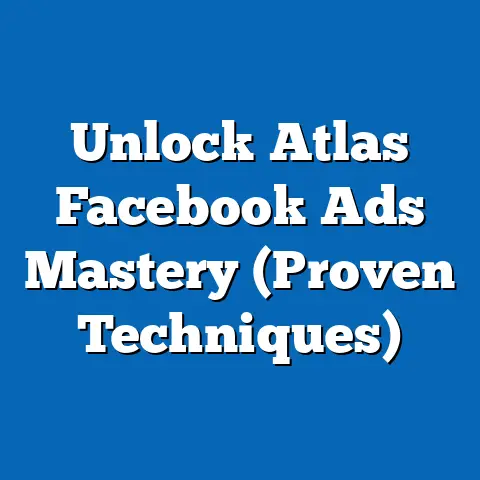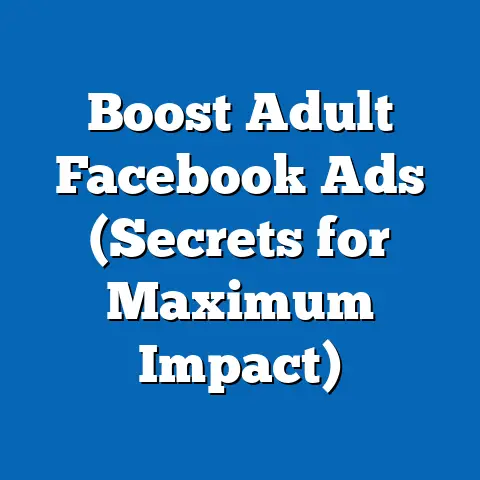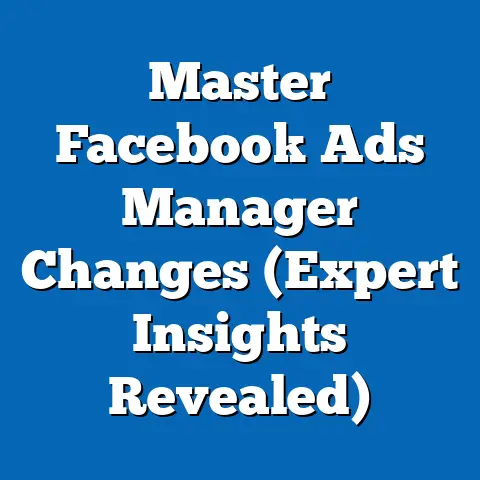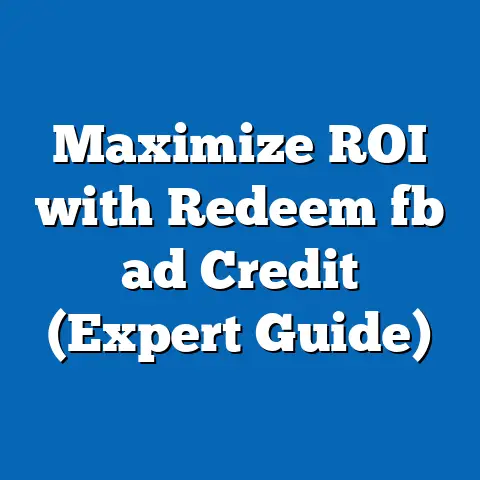Boost Facebook Ads Click Rate (Proven Strategies)
Have you ever scrolled through your Facebook feed and been stopped in your tracks by an ad? Maybe it was the vibrant colors, the intriguing image, or the promise of a solution to a problem you didn’t even know you had. That’s the power of a well-crafted Facebook ad. I’ve spent years in the digital marketing trenches, and I can tell you firsthand, a high click-through rate (CTR) is the holy grail of Facebook advertising. It’s the key to unlocking lower costs, higher conversions, and ultimately, a better ROI.
Think of it like this: a great Facebook ad is like a delicious dish. It needs the right ingredients (compelling copy, eye-catching visuals), the perfect recipe (strategic targeting, effective CTAs), and a skilled chef (you!) to bring it all together. In this guide, I’m going to share my proven strategies for boosting your Facebook ad CTR, so you can start serving up ads that get results.
Understanding Click-Through Rate (CTR)
So, what exactly is CTR, and why should you care? Simply put, Click-Through Rate (CTR) is the percentage of people who see your ad and actually click on it. It’s calculated by dividing the number of clicks your ad receives by the number of times it’s shown (impressions), then multiplying by 100.
CTR = (Total Clicks / Total Impressions) x 100
For example, if your ad is shown 1,000 times and receives 20 clicks, your CTR would be 2%.
Why is it so important?
- Relevance: A high CTR tells Facebook that your ad is relevant to the audience you’re targeting. This signals to the algorithm that your ad is providing value, which can lead to lower ad costs and better ad placement.
- Quality Score: Facebook uses CTR as one of the key factors in determining your ad’s quality score. A higher quality score can lead to lower costs per click (CPC) and higher ad ranking.
- Conversion Potential: While a click doesn’t guarantee a conversion, it’s the first step in the customer journey. A higher CTR means more people are interested in what you have to offer, increasing your chances of driving sales, leads, or whatever your desired outcome may be.
What’s a “good” CTR?
This is the million-dollar question, and the answer is: it depends. Average CTRs on Facebook vary widely depending on the industry, target audience, ad format, and campaign objective.
- Industry: Some industries, like retail and e-commerce, tend to have higher CTRs than others, like finance or insurance.
- Placement: Ads shown in the Facebook News Feed typically have higher CTRs than those shown in the right column.
- Objective: Ads optimized for engagement (likes, comments, shares) may have lower CTRs than those optimized for conversions (sales, leads).
While there’s no one-size-fits-all answer, here’s a general benchmark: a CTR of 1% or higher is generally considered good. However, don’t get too hung up on this number. The most important thing is to track your CTR over time and strive to improve it.
The Implications of High vs. Low CTR
A high CTR indicates that your ad is resonating with your target audience. It means your message is relevant, your visuals are engaging, and your offer is compelling. This can lead to:
- Lower ad costs
- Higher ad ranking
- Increased brand awareness
- More conversions
A low CTR, on the other hand, signals that something is off. It could mean your targeting is too broad, your ad copy is boring, your visuals are unappealing, or your offer is weak. This can lead to:
- Higher ad costs
- Lower ad ranking
- Wasted ad spend
- Missed opportunities
Takeaway: Understanding CTR is crucial for optimizing your Facebook ad campaigns. By tracking your CTR and analyzing the factors that influence it, you can make data-driven decisions to improve your ad performance and achieve your marketing goals.
The Psychology of Clicks
Now, let’s dive into the fascinating world of psychology and explore the triggers that make people click on ads. Understanding these principles can help you craft ads that are not only visually appealing but also psychologically persuasive.
1. Curiosity: Humans are naturally curious creatures. We’re drawn to things that pique our interest and make us want to learn more. You can leverage curiosity in your ads by:
- Asking Intriguing Questions: Pose a question that resonates with your target audience and makes them want to know the answer.
- Creating Mystery: Use vague or ambiguous language to create a sense of mystery and intrigue.
- Using “Teaser” Images: Show a glimpse of your product or service without revealing too much.
Example: I once ran an ad for a local bakery that simply showed a close-up shot of a perfectly frosted cupcake with the caption, “What’s the secret ingredient?” The ad generated a ton of clicks because people were curious to find out what made these cupcakes so special.
2. Urgency: Creating a sense of urgency can motivate people to take action now rather than later. You can create urgency by:
- Highlighting Limited-Time Offers: Promote discounts or promotions that are only available for a limited time.
- Emphasizing Scarcity: Highlight that your product or service is in limited supply.
- Using Countdown Timers: Add a countdown timer to your ad to visually reinforce the urgency.
Example: I’ve seen e-commerce stores successfully use ads with the headline, “Flash Sale! 50% Off Everything – Ends Tonight!” The limited-time offer creates a sense of urgency that drives clicks and sales.
3. Social Proof: People are more likely to take action if they see that others are doing it too. You can leverage social proof by:
- Displaying Customer Testimonials: Share positive reviews or testimonials from satisfied customers.
- Showcasing User-Generated Content: Feature photos or videos of your product or service being used by real people.
- Highlighting Social Media Engagement: Show the number of likes, comments, or shares your ad has received.
Example: I worked with a fitness studio that ran ads featuring before-and-after photos of their clients. The ads generated a lot of clicks because people saw the tangible results that others had achieved, making them believe they could achieve similar results.
4. Pain Points: Addressing your target audience’s pain points can be a powerful way to grab their attention and motivate them to click. You can do this by:
- Identifying Common Problems: Research your target audience to understand their biggest challenges and frustrations.
- Highlighting Solutions: Show how your product or service can solve their problems and make their lives easier.
- Using Empathy: Show that you understand their pain and that you’re there to help.
Example: I helped a software company create ads that addressed the common pain points of small business owners, such as managing finances and tracking inventory. The ads generated a lot of clicks because they spoke directly to the challenges that small business owners face every day.
5. Value Proposition: Clearly communicating the value of your product or service is essential for driving clicks. You can do this by:
- Highlighting Key Benefits: Focus on the most important benefits of your product or service.
- Quantifying Results: Use numbers to demonstrate the value you provide (e.g., “Save 20%,” “Increase Your Productivity by 50%”).
- Offering Freebies: Offer a free trial, discount, or bonus to incentivize clicks.
Example: I’ve seen online courses successfully use ads with the headline, “Learn a New Skill in 30 Days and Boost Your Career.” The ad clearly communicates the value of the course and offers a tangible benefit (career advancement).
Takeaway: By understanding the psychological triggers that influence user behavior, you can craft Facebook ads that are more compelling, persuasive, and likely to generate clicks. Experiment with different approaches to see what resonates best with your target audience.
Crafting Compelling Ad Copy
Now that we’ve explored the psychology behind clicks, let’s talk about the art of writing ad copy that grabs attention and drives action. Your ad copy is your opportunity to tell a story, highlight your value proposition, and persuade people to click.
1. Know Your Audience: Before you start writing, take the time to understand your target audience. What are their interests, needs, and pain points? What language do they use? The more you know about your audience, the better you can tailor your ad copy to resonate with them.
2. Keep it Concise: People have short attention spans, especially when scrolling through their Facebook feed. Get to the point quickly and use clear, concise language. Avoid jargon or technical terms that your audience may not understand.
3. Highlight the Benefits: Focus on the benefits of your product or service, not just the features. What problem does it solve? How will it make their lives easier? People are more likely to click on ads that offer tangible benefits.
4. Use Strong Action Words: Incorporate powerful action words that encourage people to take action. Examples include:
- Learn More
- Shop Now
- Get Started
- Sign Up
- Download
- Claim Your Offer
5. Create a Sense of Urgency: As we discussed earlier, creating a sense of urgency can motivate people to click. Use phrases like “Limited Time Offer,” “Sale Ends Soon,” or “Don’t Miss Out.”
6. Ask Questions: Asking questions can pique people’s interest and make them want to learn more. Use questions that are relevant to your target audience and that highlight their pain points.
7. Use Numbers and Statistics: Numbers and statistics can add credibility to your ad copy and make your claims more believable. For example, “Save 20% on Your First Order” or “Join Over 10,000 Satisfied Customers.”
8. Tell a Story: People love stories. Use your ad copy to tell a brief story that resonates with your target audience and highlights the benefits of your product or service.
9. Use Emojis: Emojis can add personality to your ad copy and make it more visually appealing. However, use them sparingly and make sure they’re relevant to your message.
10. A/B Test Your Ad Copy: Don’t be afraid to experiment with different versions of your ad copy to see what performs best. A/B testing can help you identify the most effective headlines, body text, and calls to action.
Example of High-Performing Ad Copy:
Let’s say you’re selling a productivity app for freelancers. Here’s an example of ad copy that incorporates many of the principles we’ve discussed:
Headline: Tired of Juggling Multiple Projects?
Body Text: Freelancers, are you struggling to stay organized and on top of your deadlines? Our productivity app can help you streamline your workflow, manage your tasks, and get more done in less time.
Benefits:
- Stay organized and on top of your deadlines
- Streamline your workflow
- Manage your tasks
- Get more done in less time
Call to Action: Try it Free for 14 Days!
Why this ad copy works:
- It identifies a common pain point for freelancers (juggling multiple projects).
- It highlights the benefits of the app in a clear and concise way.
- It uses strong action words (“Try it Free”).
- It offers a free trial to incentivize clicks.
Takeaway: Crafting compelling ad copy is essential for driving clicks and achieving your Facebook advertising goals. By understanding your audience, highlighting the benefits of your product or service, and using strong action words, you can create ads that resonate with your target audience and motivate them to take action.
Designing Eye-Catching Visuals
In the world of Facebook advertising, visuals are king. Your ad’s image or video is often the first thing people see, so it’s crucial to make a strong impression. A compelling visual can grab attention, communicate your message, and entice people to click.
1. Use High-Quality Images and Videos: This may seem obvious, but it’s worth repeating. Use images and videos that are clear, sharp, and well-lit. Avoid blurry or pixelated visuals that can make your ad look unprofessional.
2. Choose Relevant Visuals: Your visuals should be relevant to your ad copy and your target audience. Use images or videos that showcase your product or service in action or that resonate with your audience’s interests and values.
3. Use Eye-Catching Colors: Colors can evoke emotions and grab attention. Use colors that are consistent with your brand and that stand out from the Facebook News Feed. Consider using bright, contrasting colors to make your ad pop.
4. Optimize for Mobile: The majority of Facebook users access the platform on their mobile devices. Make sure your visuals are optimized for mobile viewing. Use images and videos that are properly sized and that look good on smaller screens.
5. Use Text Overlays Sparingly: While it can be tempting to add text overlays to your visuals, use them sparingly. Too much text can make your ad look cluttered and overwhelming. Focus on using a strong visual and let your ad copy do the talking.
6. A/B Test Your Visuals: Just like with ad copy, it’s important to A/B test your visuals to see what performs best. Experiment with different images, videos, and color schemes to see what resonates most with your target audience.
7. Consider Using User-Generated Content: As we discussed earlier, user-generated content can be a powerful form of social proof. Consider using photos or videos of your product or service being used by real people.
8. Use Motion Graphics: Motion graphics can be a great way to grab attention and communicate your message in a dynamic and engaging way. Consider using animated GIFs or short videos to showcase your product or service.
9. Use Professional Photography and Videography: Investing in professional photography and videography can make a big difference in the quality of your ads. A professional photographer or videographer can help you create visuals that are visually appealing, well-lit, and optimized for Facebook advertising.
10. Keep Up With Trends: Stay up-to-date with the latest trends in visual design. What types of images and videos are popular on Facebook right now? What are the latest design trends? By staying on top of trends, you can create visuals that are fresh, relevant, and engaging.
Example of Successful Visual:
I worked with a travel agency that ran ads featuring stunning photos of exotic destinations. The photos were high-quality, visually appealing, and relevant to the travel agency’s target audience. The ads generated a lot of clicks because people were drawn to the beautiful imagery and were inspired to book their next vacation.
Takeaway: Designing eye-catching visuals is essential for capturing attention and driving clicks on Facebook. By using high-quality images and videos, choosing relevant visuals, and optimizing for mobile, you can create ads that stand out from the crowd and resonate with your target audience.
Targeting the Right Audience
Even the most compelling ad copy and visually stunning images will fall flat if you’re not targeting the right audience. Targeting is the key to reaching the people who are most likely to be interested in your product or service.
1. Define Your Ideal Customer: Before you start targeting, take the time to define your ideal customer. Who are they? What are their interests, needs, and pain points? The more you know about your ideal customer, the better you can target your ads.
2. Use Facebook’s Targeting Options: Facebook offers a wide range of targeting options, including:
- Demographics: Target people based on their age, gender, education, relationship status, and location.
- Interests: Target people based on their interests, hobbies, and activities.
- Behaviors: Target people based on their online behavior, such as their purchase history, travel habits, and device usage.
- Custom Audiences: Target people who have already interacted with your business, such as website visitors, email subscribers, or customers.
- Lookalike Audiences: Target people who are similar to your existing customers.
3. Layer Your Targeting: Don’t rely on just one targeting option. Layer your targeting to narrow down your audience and reach the people who are most likely to be interested in your product or service.
4. Exclude Irrelevant Audiences: Just as important as targeting the right people is excluding the wrong people. Exclude audiences that are not relevant to your business to avoid wasting your ad spend.
5. Test Different Audiences: Don’t be afraid to experiment with different audiences to see what performs best. A/B testing can help you identify the most responsive audiences for your ads.
6. Use Retargeting: Retargeting is a powerful strategy for reaching people who have already interacted with your business. Retarget website visitors, email subscribers, or customers who have abandoned their shopping carts.
7. Monitor Your Audience Performance: Pay attention to how different audiences are performing. Which audiences are generating the most clicks, leads, or sales? Adjust your targeting based on your performance data.
8. Use Facebook Pixel: The Facebook Pixel is a small piece of code that you can install on your website to track website visitors and their actions. The Pixel can help you create custom audiences, optimize your ads for conversions, and track your ad performance.
9. Consider Using Broad Targeting: In some cases, broad targeting can be more effective than narrow targeting. Broad targeting can help you reach new audiences that you may not have considered.
10. Stay Up-to-Date With Facebook’s Targeting Changes: Facebook is constantly making changes to its targeting options. Stay up-to-date with the latest changes to ensure that you’re using the most effective targeting strategies.
Example of Successful Targeting:
I worked with an online clothing store that wanted to increase sales. We targeted women aged 25-45 who were interested in fashion, online shopping, and specific clothing brands. We also created a lookalike audience based on the store’s existing customers. The ads generated a lot of sales because we were targeting a highly relevant audience.
Takeaway: Targeting the right audience is essential for maximizing your Facebook ad CTR and achieving your marketing goals. By defining your ideal customer, using Facebook’s targeting options, and testing different audiences, you can reach the people who are most likely to be interested in your product or service.
Utilizing Facebook Ad Formats
Facebook offers a variety of ad formats, each with its own unique strengths and weaknesses. Choosing the right ad format can significantly impact your CTR and overall campaign performance.
1. Image Ads: Image ads are the most basic and widely used ad format on Facebook. They consist of a single image, ad copy, and a call to action. Image ads are great for showcasing your product or service in a visually appealing way.
2. Video Ads: Video ads are a more engaging and dynamic ad format than image ads. They can be used to tell a story, demonstrate your product or service, or share customer testimonials. Video ads tend to have higher CTRs than image ads.
3. Carousel Ads: Carousel ads allow you to showcase multiple images or videos in a single ad unit. This format is great for highlighting different features of your product or service, telling a story, or showcasing a variety of products.
4. Collection Ads: Collection ads are a mobile-first ad format that allows you to showcase a catalog of products in a visually appealing way. This format is great for e-commerce businesses that want to drive sales.
5. Instant Experience Ads: Instant Experience ads (formerly known as Canvas ads) are full-screen, mobile-optimized ads that load instantly when someone clicks on them. This format allows you to create a highly immersive and engaging experience for your audience.
6. Lead Ads: Lead ads are designed to collect leads directly from Facebook. This format is great for businesses that want to generate leads for their sales team.
7. Messenger Ads: Messenger ads appear in the Facebook Messenger app. This format is great for businesses that want to connect with their audience on a more personal level.
8. Stories Ads: Stories ads appear in the Facebook Stories feed. This format is great for businesses that want to reach a younger audience.
9. Playable Ads: Playable ads are interactive ads that allow users to try out a game or app before downloading it. This format is great for app developers who want to drive downloads.
10. Augmented Reality Ads: Augmented Reality (AR) ads allow users to try on products virtually using their smartphone camera. This format is great for businesses that sell products that are difficult to try on in person, such as clothing or makeup.
Choosing the Right Ad Format:
The best ad format for your business will depend on your campaign goals, target audience, and the type of product or service you’re selling.
- For Brand Awareness: Video ads, Instant Experience ads, and Stories ads are great for raising brand awareness.
- For Lead Generation: Lead ads and Messenger ads are great for generating leads.
- For Sales: Carousel ads, Collection ads, and Image ads are great for driving sales.
Example of Successful Ad Format Usage:
I worked with a restaurant that wanted to increase reservations. We used Carousel ads to showcase different dishes from their menu. Each image featured a mouth-watering photo of a dish, along with a brief description and the price. The ads generated a lot of reservations because people were drawn to the delicious-looking food and were inspired to make a reservation.
Takeaway: Utilizing the right Facebook ad format is crucial for maximizing your ad CTR and achieving your marketing goals. By understanding the strengths and weaknesses of each format and choosing the one that best aligns with your campaign objectives, you can create ads that are more engaging, effective, and likely to generate clicks.
Implementing Effective Call-to-Actions (CTAs)
Your call-to-action (CTA) is the final piece of the puzzle. It’s the instruction that tells people what you want them to do after seeing your ad. A strong CTA can be the difference between a click and a scroll.
1. Use Clear and Concise Language: Your CTA should be clear and concise, telling people exactly what you want them to do. Avoid vague or ambiguous language that can confuse your audience.
2. Create a Sense of Urgency: As we discussed earlier, creating a sense of urgency can motivate people to take action. Use phrases like “Shop Now,” “Get Yours Today,” or “Limited Time Offer.”
3. Highlight the Benefits: Your CTA should highlight the benefits of taking action. What will people gain by clicking on your ad?
4. Use Strong Action Words: Use strong action words that encourage people to take action. Examples include:
- Shop Now
- Learn More
- Sign Up
- Download
- Get Started
- Claim Your Offer
5. Make it Visually Appealing: Your CTA should be visually appealing and easy to see. Use a button with a contrasting color and a clear font.
6. A/B Test Your CTAs: Just like with ad copy and visuals, it’s important to A/B test your CTAs to see what performs best. Experiment with different wording, colors, and placements to see what resonates most with your target audience.
7. Consider the Placement of Your CTA: The placement of your CTA can also impact its effectiveness. Experiment with different placements to see what works best for your ad format.
8. Use a CTA That Aligns With Your Campaign Goal: Your CTA should align with your campaign goal. If you’re trying to generate leads, use a CTA like “Sign Up” or “Get a Free Quote.” If you’re trying to drive sales, use a CTA like “Shop Now” or “Buy Now.”
9. Use a CTA That is Relevant to Your Audience: Your CTA should be relevant to your audience and their needs. Use language that resonates with your target audience and that speaks to their pain points.
10. Track Your CTA Performance: Track the performance of your CTAs to see what’s working and what’s not. Which CTAs are generating the most clicks, leads, or sales? Adjust your CTAs based on your performance data.
Examples of Effective CTAs:
- Shop Now and Get Free Shipping
- Learn More About Our New Product
- Sign Up for Our Free Newsletter
- Download Our Free Ebook
- Get Started Today and Save 20%
- Claim Your Free Trial Now
Takeaway: Implementing effective CTAs is crucial for driving clicks and achieving your Facebook advertising goals. By using clear and concise language, creating a sense of urgency, and highlighting the benefits of taking action, you can create CTAs that motivate people to click on your ads.
Analyzing and Optimizing Performance
Congratulations! You’ve created a compelling Facebook ad with eye-catching visuals, targeted the right audience, and implemented an effective call-to-action. But your work isn’t done yet. The key to long-term success is to continuously analyze your ad performance and optimize your campaigns based on your data.
1. Track Your Key Metrics: The first step in analyzing your ad performance is to track your key metrics. These metrics will give you insights into how your ads are performing and what you can do to improve them. Key metrics to track include:
- Click-Through Rate (CTR): As we’ve discussed throughout this guide, CTR is a key indicator of ad relevance and engagement.
- Cost Per Click (CPC): CPC is the amount you pay each time someone clicks on your ad.
- Cost Per Mille (CPM): CPM is the amount you pay for 1,000 impressions of your ad.
- Conversion Rate: Conversion rate is the percentage of people who click on your ad and then take a desired action, such as making a purchase or signing up for a newsletter.
- Cost Per Acquisition (CPA): CPA is the amount you pay for each conversion.
- Return on Ad Spend (ROAS): ROAS is the amount of revenue you generate for every dollar you spend on advertising.
2. Use Facebook Ads Manager: Facebook Ads Manager is a powerful tool that allows you to track your ad performance, analyze your data, and make changes to your campaigns. Use Ads Manager to monitor your key metrics, identify trends, and make data-driven decisions.
3. A/B Test Everything: A/B testing is a crucial part of optimizing your ad performance. A/B test different versions of your ad copy, visuals, CTAs, and targeting to see what performs best.
4. Analyze Your Audience Performance: Pay attention to how different audiences are performing. Which audiences are generating the most clicks, leads, or sales? Adjust your targeting based on your performance data.
5. Monitor Your Ad Frequency: Ad frequency is the number of times each person sees your ad. If your ad frequency is too high, people may get tired of seeing your ad and stop clicking on it. Monitor your ad frequency and adjust your targeting or ad creative to avoid ad fatigue.
6. Refresh Your Ad Creative: Even the most compelling ad creative will eventually lose its effectiveness. Refresh your ad creative regularly to keep your ads fresh and engaging.
7. Adjust Your Bidding Strategy: Facebook offers a variety of bidding strategies. Experiment with different bidding strategies to see what works best for your campaign goals.
8. Consider Using Automated Rules: Facebook allows you to create automated rules that automatically make changes to your campaigns based on your performance data. Automated rules can help you save time and optimize your ad performance.
9. Stay Up-to-Date With Facebook’s Algorithm Changes: Facebook’s algorithm is constantly changing. Stay up-to-date with the latest changes to ensure that you’re using the most effective strategies.
10. Don’t Be Afraid to Experiment: Don’t be afraid to experiment with different strategies to see what works best for your business. The key to success is to continuously test, analyze, and optimize your campaigns.
Takeaway: Analyzing and optimizing your Facebook ad performance is an ongoing process. By tracking your key metrics, using Facebook Ads Manager, and A/B testing everything, you can continuously improve your ad performance and achieve your marketing goals.
Conclusion
Boosting your Facebook ads click rate isn’t about finding a magic bullet. It’s about understanding your audience, crafting compelling content, utilizing the right ad formats, and continuously analyzing and optimizing your campaigns. It’s a multi-faceted approach that requires creativity, data analysis, and a willingness to experiment.
I’ve shared my proven strategies for boosting your Facebook ad CTR, and I encourage you to implement them in your own campaigns. Remember, the key to success is to continuously test, analyze, and optimize your ads based on your data.
By following the strategies outlined in this guide, you can create Facebook ads that are more engaging, effective, and likely to generate clicks. This will lead to lower ad costs, higher conversions, and ultimately, a better ROI for your business. Now go out there and start creating some amazing Facebook ads!

